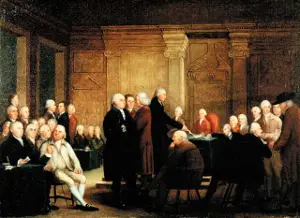Part 2: The Second Continental Congress The Continental Congress did indeed meet again on May 10, 1775, with many of the initial delegates attending again. (Two new members were Benjamin Franklin and Thomas Jefferson.) Georgia delegates attended this time. Peyton Randolph was again named president. When Randolph had to leave in order to conduct other business, John Hancock stepped in as president. Circumstances were very much different. The Revolutionary War had begun, with the "Shot Heard Round the World" at Lexington and Concord. The Second Continental Congress, as it came to be known, went in to war mode, creating the Continental Army, Continental Navy, and Continental Marines and naming George Washington as head of those forces. The Congress tasked the individual colonies with supplying men, supplies, and money to fund the war effort. In other examples of performing the functions of a federal government, the Congress printed its own money, established a post office, and appointed commissioners to conduct negotiations with Native Americans. Even against the backdrop of war, many in the Continental Congress still pursued a solution that didn't involve independence. One of the most prominent of these was John Dickinson, who had gained fame for his Letters from a Farmer in Pennsylvania in response to the Townshend Acts. Dickinson helped draft the "Olive Branch Petition," which the Congress approved in July 1775, two days after approving a Declaration of Causes laying out the colonies' rationale for resorting to taking up arms. The delegates pledged their loyalty to the Crown and sought a peaceful resolution to the dilemma that they all faced. About the same time, British Prime Minister Lord North had offered a compromise of sorts: He promised that Parliament would not tax the colonies directly but that colonial assemblies would still collect taxes from colonists and then forward the taxes collected to Parliament. The Congress rejected North's proposal. The response to the Olive Branch Petition from King George III was to refuse to even read it and, further, to declare the colonies to be in a state of rebellion. The king took the further alienating step of hiring a large number of Hessian mercenaries to fight alongside the British Army. As late as December 1775, the Continental Congress was still trying to find a way forward; King George III continued to have other ideas. The next month, however, saw the release of Thomas Paine's famous Common Sense, which contained a series of convincing arguments for the need for the colonists to go their own way. The Continental Army had a small measure of success in March 1776, when it forced British forces to leave Boston. On June 7, Richard Henry Lee of Virginia introduced a proposal for independence; the Congress postponed a final vote until July 1 but also selected a committee to draft a declaration of independence. On that committee were John Adams, Franklin, Jefferson, R.R. Livingston, and Roger Sherman. In August 1776, the Continental Congress issued an order for the colonies to form new governments. The Congress appointed a committee of 13, led by Dickinson, to craft a blueprint for confederation. The result was the Articles of Confederation. The Continental Congress had gathered in Philadelphia. British successes on the field of battle forced the Congress to relocate a few times: to Baltimore in 1776, back to Philadelphia (1777), to Lancaster, Pa. (1777), to York, Pa. (1777), and finally back to Philadelphia, in 1778. This forced the Continental Congress to relocate to York, Pa. This was the first of several relocations; the others were The Congress continued to meet off and on until March 1781. First page > The First Continental Congress > Page 1, 2 |
|
Social Studies for Kids
copyright 2002–2024
David White

 Jefferson did most of the writing, and the committee delivered its draft for the Congress to consider. The Congress accepted most of the wording as it was; one prime revision was to remove any suggestion that slavery was an institution to be opposed. Congress on July 4, 1776, approved the
Jefferson did most of the writing, and the committee delivered its draft for the Congress to consider. The Congress accepted most of the wording as it was; one prime revision was to remove any suggestion that slavery was an institution to be opposed. Congress on July 4, 1776, approved the 
